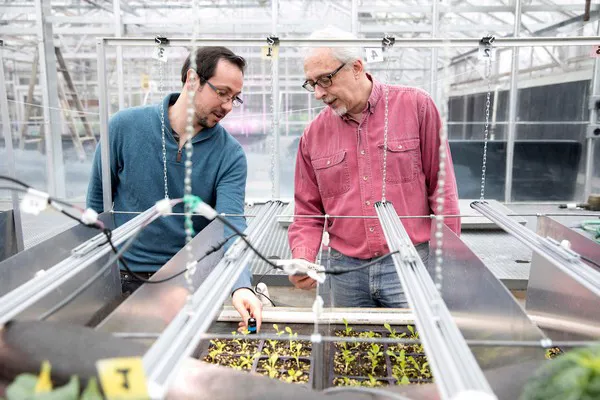The illuminated light bulb. It’s the symbol of a great idea come to life.
Erico Mattos’ big idea doesn’t reinvent that iconic bulb exactly but reimagines how it can be used.
Around the globe, greenhouses grow fruits and vegetables to provide a healthy food supply year-round. But as reliable as the sun is for providing light and energy for plants to grow, a rainy day or just a cloudy afternoon can slow a plant’s growth little by little. Those cloudy days add up and can affect how quickly a plant grows — including how deep its roots take hold—and how much it can produce. Some greenhouse growers use artificial lighting. But to shine a light on a plant that’s already getting ample sunlight is a waste of energy … and money.
After finishing his doctorate in bioengineering at the University of Georgia, Mattos teamed up with Marc van Iersel, the Dooley Professor of Horticulture, to develop a lighting controller that can respond to sunlight and provide just enough supplemental light to keep plants happy. The lights dim under sunny conditions and get brighter under cloudy conditions.
“We provide the plants just the amount of light that they need,” says Mattos. “No more. No less.”
The idea has the potential to give the nearly $15 billion greenhouse farming industry a reliable, energy-saving process, which could ensure peak growth and profit margins and provide a more stable global food supply. Or at least that’s what Mattos suspected. Still, he wasn’t entirely sure if his lab work would translate into the real-world needs of greenhouse growers.
This could have been “a really cool idea and a bunch of academic papers,” van Iersel says. Instead, Mattos and van Iersel committed to bringing the idea to market by creating a startup. They named their company Candidus, Latin for “radiant.”

Erico Mattos (left) co-founded his startup company Candidus with Mark van Iersel, Dooley Professor of Horticulture, CAES. Candidus uses lighting sensors to improve greenhouse farming production. (Photo by Dorothy Kozlowski/UGA)
Finding a path to success
Mattos and van Iersel turned to a UGA program that’s helping faculty and students take their big ideas and entrepreneurial aspirations and pressure test them for the market. Innovation Corps, or I-Corps, was developed by the National Science Foundation to help scientists and engineers in the U.S. extend their academic research for economic and societal benefits. At UGA, teams go through a six-week accelerator program to identify market need and potential customers for their idea.
It’s an important step, says Ian Biggs, director of the Startup Program within UGA’s Innovation Gateway, the university’s instrument for commercializing UGA research.
Across industries, the failure rate for startup companies is grim, 90% by some estimates. But data show 40% fail because customers don’t need — or at least think they don’t need—what’s being sold.
“You are going to fail if you have something that nobody cares about,” says Biggs. If he sounds blunt, it’s from years of experience in entrepreneurship and startups on both sides of the Atlantic Ocean. Before coming to Athens, the Oxford-educated Biggs worked in finance for several international banks and was part of a handful of animal breeding startups — including the team that brought the world’s first cloned sheep, Dolly, to life.
A flourishing ecosystem
As rapidly as technology seems to be evolving, the process for bringing university ideas to consumers has gotten more complex, Biggs says. Years ago, big industry partners would shop around for the best ideas in academia and then buy the rights to take those ideas, potentially prototype them, and then determine if they were market ready. These days, companies are less likely to invest in ideas unless they are sure things. Through its Innovation District initiative, UGA is stepping up to help faculty and students develop their research to have the greatest impact on society.
The success in this effort speaks for itself. Last year, UGA ranked first among 193 U.S. institutions for the number of commercial products reaching the market, according to a survey released by the nonprofit AUTM, which tracks technology transfer. In the same survey, UGA ranked fourth in the number of new intellectual property licenses executed to industry. So far, the bulk of that success comes from existing companies licensing UGA technology, but the university is strengthening its efforts to support startup companies based on university research.
